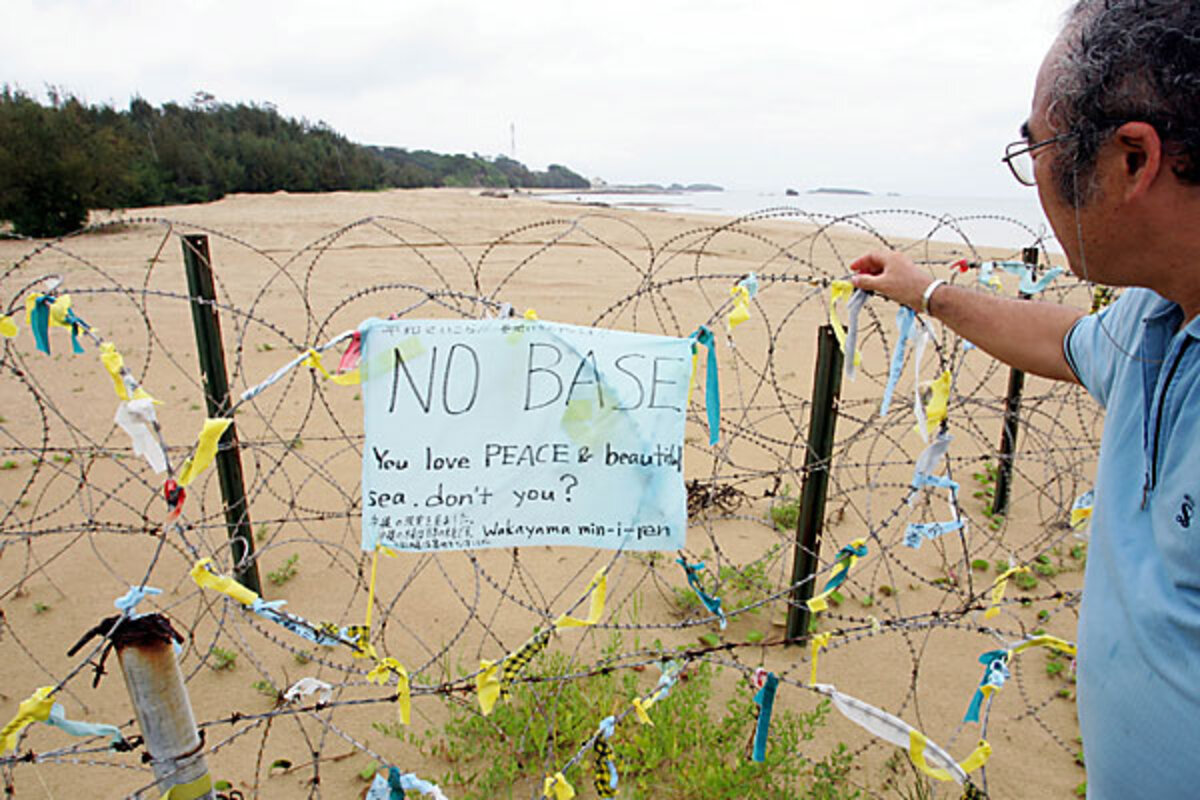Japan stymied on US base in Okinawa as deadline nears
Loading...
| Ginowan, Okinawa, Japan
On the steps up to a lookout point over Futenma, a United States Marine Corps helicopter base in the middle of downtown Ginowan, blue spray-painted graffiti carries a blunt message: “NO BASE MORE.”
The fractured English does not weaken the sentiment, almost universally shared here, that the noisy and potentially dangerous base must be closed. The US and Japanese governments agree.
Where its operations might be moved to, however, is an awkward question that could weaken America’s 50-year-old security alliance with Japan.
For 14 years, Japanese governments have wrestled with the issue of where to base the Marine Corps’ helicopters. They have tried, and failed, to reconcile the US insistence that the aircraft be stationed near the troops they would transport with local opposition to any new or expanded US bases.
Mr. Hatoyama’s Democratic Party of Japan (DPJ) won office last August – unseating the Liberal Democratic Party in an election for the first time in more than half a century – partly on a campaign pledge to move Futenma operations off the southern island of Okinawa, and preferably out of Japan.
But as a May deadline for a decision approaches, the government is backing away from that promise and deciding that the small fishing village of Henoko, next to an existing US Marine base some 50 miles north of here, offers the best solution. That was the deal Washington and Tokyo reached in 1996, but it has been repeatedly blocked by antibase activists in Henoko.
“We don’t have many choices,” says one senior government official, who asked not to be identified because of the sensitivity of the issue. “It’s between the current plan [for a long runway in landfill in the bay] and a slightly revised plan,” he adds.
For US, a strategic choice
US military planners insist that alternative ideas, such as moving the helicopters to Guam, or anywhere far from Okinawa, are unrealistic.
“We cannot separate the helicopters from the forces they are supporting,” says Lt. Gen. Keith Stalder, the top Marine Corps commander in the Pacific. “The helicopters have got to train with the marines they are supporting or they become unproficient.”
Okinawa’s location, Stalder adds, “is strategically very good.” A subtropical island closer to Taiwan than to Tokyo, its military bases mean “we can be a very credible presence and quickly get where we need to get.”
The US-Japan security alliance rests on two pillars: Washington agrees to defend Japan against aggression and help maintain stability in its neighborhood, while Japan agrees to provide bases for US forces doing that job.
If the helicopters now operating out of Futenma were not to find a new base in Japan, and if the troops they must train with were to follow them elsewhere, one pillar of the alliance would crumble.
“This is not about local political issues, it’s a strategic issue – regional security and the health and future of the alliance,” says Stalder.
In Japan, a political issue
Susumu Inamine would beg to differ. In January he won election as mayor of Nago – which has jurisdiction over Henoko – after campaigning against any new US helicopter base.
“The negatives, the environmental destruction, the noise, the danger, outweigh any economic benefits” that a new base might bring, says Mr. Inamine. “Our position is not going to change; we oppose the idea."
So does the Okinawa Prefecture Assembly, which unanimously passed a motion last week opposing the Henoko plan.
Peace activists who successfully blocked the construction of a planned offshore landing strip five years ago, by physically challenging construction workers, say they are equally determined to stymie any new project, which they say is too expensive and too damaging to the wildlife in the bay off Henoko.
“The democratic voice of the people should be respected,” says Hiroshi Ashitomi, cochairman of the Conference Opposing Heliport Construction,” which has organized a beachside sit-in that has lasted six years.
“If they ignore Okinawan voices, they will get payback,” Mr. Ashitomi adds. “We will fight any construction.”
The DPJ’s junior coalition partner, the Social Democratic Party, has threatened to withdraw from the government if Hatoyama presses ahead with the Henoko plan. The prime minister, however, does not rely on the SDP for a parliamentary majority and is expected to risk a desertion.
The government appears to have discarded the current plan to relocate Futenma, which foresees twin runways extending into the sea from a promontory just outside Henoko. Instead, officials say, they are proposing a shorter airstrip on land. “The bottom line is to ensure that the marine environment is not destroyed,” explains the senior government official.
It is doubtful, however, that such an alternative will be acceptable to the US side. At an earlier stage of the protracted negotiations over a replacement facility for Futenma, the Marines rejected a short onshore runway for operational and safety reasons.
That would appear to leave the situation as intractable as ever, and the American side increasingly impatient.
“The current plan is the best plan, and it was reached after years of consultation,” says Stalder. “We’ve got to get after it.”
-----
Follow us on and .




